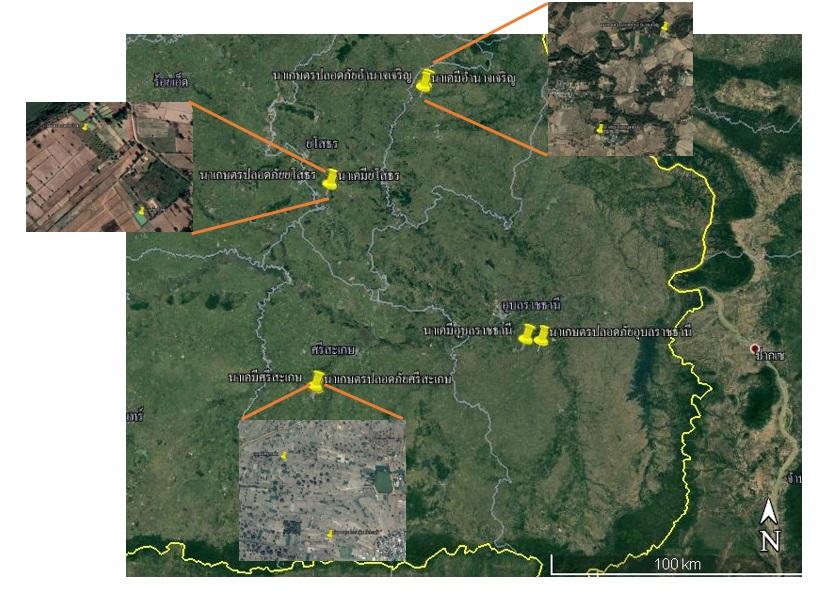Biodiversity of Aquatic Insects in Good Agricultural Practices Rice Fields in Lower Northeastern
Keywords:
Aquatic Insects, Good Agricultural Practices, Water quality, Rice fieldAbstract
Good Agricultural Practices (GAP) was promoted for food agriculture system for preventing and reducing the health risk harmful. The most significant specification for GAP is non-contaminate of hazardous chemicals in water resource. The objective of this study was investigated the biodiversity of aquatic insects in GAP rice fields comparing with chemical rice fields. Aquatic insect and water quality in rice fields were investigated in lower northeastern, Sisaket, Amnat Charoen, Yasothon and Ubon Ratchathani, during March, August and December 2018. The results of aquatic insect biodiversity and distribution showed that Shannon-Wiener’s index: H' in GAP rice field was significantly higher than chemical rice field in all sites study (p < 0.05). The most abundant of aquatic insects was found in GAP rice field at Yasothon site. Seven orders and 17 families were recorded. Hemipteran was the highest in abundance groups in the fields (7 families) followed by Odonata (3 families), Trichopteran (2 families), Coleopteran (2 families), Ephemeroptera (1 families), Dipteran (1 families) and Plecopteran (1 families). While, the least abundant was found in chemical rice field at Amnat Charoen site, 4 orders and 8 families. In addition, bio-indicator insects for good water quality were found in GAP rice fields which is consistent with the results of water quality, high dissolved oxygen and low biochemical oxygen demand.
References
National Bureau of Agricultural Commodity and Food Standards. Good Agricultural Practices for Food Crop. Ministry of Agriculture and Cooperatives; 2561: 22.
Prommi T. Biodiversity of aquatic insects in rice fields. SDU Res. J. 2555; 5(1): 35-46.
Soontornprasit K. Use of aquatic insects as bioindicators of water quality in Kwan Phayao, Phayao Province. Journal of community development research. 2012; 5(1): 15-24.
Soontornprasit K, Soryjit S. and Tasuetong K. Use of aquatic insects as bioindicators of water quality in Tributaries of Kwan Phayao. Khon Kaen Agr. J. 2016; 44(suppl.1): 723-730.
Soontornprasit K, Valunpion S and Pithakpol S. Biodiversity of aquatic insects in the Ing River. Khon Kaen Agr. J. 2013; 41(suppl1): 142-148.
Sangpradub N and Boonsoong B. Identification of freshwater invertebrates of the Mekong River and its tributaries. Vientiane: Mekong River Commission; 2006: 274.
Boonsoong B. Field guide to larvae of mayflies, stoneflies and caddisflies of Thailand. Bangkok: Kasetsart University press; 2014: 178.
Mongkolchaichana E, Butcher B A, Lekprayoon J and Fuangarom M. Water Striders (Hemiptera: Gerridae): Biology ana Taxonomy. Bangkok: Sirabuth press; 2012: 152.
Thongphak D and Boonthaiiwai C. Diversity of aquatic insects in the organic and conventional rice fields in Knon Kaen Thailand. Int. j. environ. rural dev. 2016; 7(2): 57-62.
Water quality and management office. Manual of water quality monitoring using by macro- invertebrate. Pollution Control Department; 2005: 48.
Barman B and Gupta S. Aquatic insects as bio-indicator of water quality – a study on Bakuamari stream, Chakras hila wildlife sanctuary, Assam, North East India. J. Entomol. Zool. Stud. 2015; 3(3): 178-186.
Kankawe K and Hanjavanit C. Odonates from Huai Nonghing, Seka district, Buengkan province. Proceeding of 13th Graduate Research Conference of Khon Kaen University; 2012: 487-495.
Settle W H, Ariawan H, Astuti E T and Cahyana W. Managing tropical rice pests through conservation of generalist enemies and alternative prey. Ecology. 1996; 77(7): 1975-1988.

Downloads
Published
How to Cite
Issue
Section
License
Copyright (c) 2020 Naresuan Phayao Journal

This work is licensed under a Creative Commons Attribution-NonCommercial-NoDerivatives 4.0 International License.
ผู้นิพนธ์ต้องรับผิดชอบข้อความในบทนิพนธ์ของตน มหาวิทยาลัยพะเยาไม่จำเป็นต้องเห็นด้วยกับบทความที่ตีพิมพ์เสมอไป ผู้สนใจสามารถคัดลอก และนำไปใช้ได้ แต่จะต้องขออนุมัติเจ้าของ และได้รับการอนุมัติเป็นลายลักษณ์อักษรก่อน พร้อมกับมีการอ้างอิงและกล่าวคำขอบคุณให้ถูกต้องด้วย
The authors are themselves responsible for their contents. Signed articles may not always reflect the opinion of University of Phayao. The articles can be reproduced and reprinted, provided that permission is given by the authors and acknowledgement must be given.







